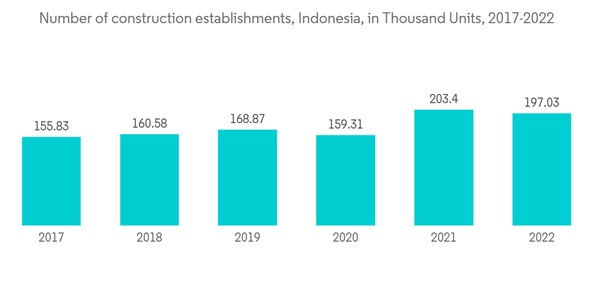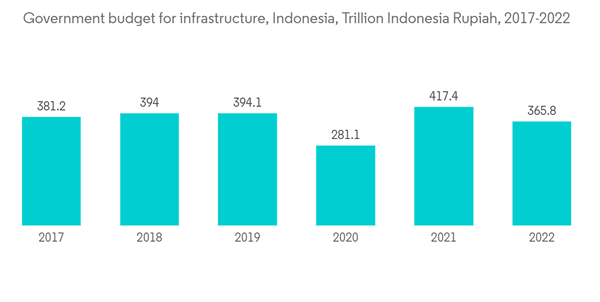The Indonesia Infrastructure Sector Market size is estimated at USD 95.78 billion in 2024, and is expected to reach USD 126.27 billion by 2029, growing at a CAGR of 5.68% during the forecast period (2024-2029).
This product will be delivered within 2 business days.
Key Highlights
- Indonesia's government increased its infrastructure investments by USD 429.7 billion in 2020-2024, up 20% from USD 359.2 billion in 2015-2019. After a decline brought on by the COVID-19 crisis, aggregate production in Indonesia significantly increased in 2021. The Indonesian government has initiated a program to upgrade basic infrastructure, including roads, airports, and seaports, which will likely stimulate demand for building materials. Infrastructure development was given IDR 414 trillion (USD 28.5 billion) in the country's 2021 state budget, a 47% increase from the 2020 budget.
- According to the spokesperson of Volvo Construction Equipment, several ongoing significant projects are boosting the demand for aggregates and quarrying equipment in the nation.
- Infrastructure financing through the country's Government and Private Cooperation Scheme reached 83 projects with a total investment of USD 40 billion. About 30 projects totaling USD 50 billion were generated for the non-government budget expenditure financing scheme.
- In 2021, the PUPR Ministry continued its priority and strategic initiatives to improve national priority achievements, including infrastructure, balanced regional growth, and the sustainability of food, energy, and living climate in the infrastructure sector. These national priorities are implemented through water resource management by improving quantity, quality, and water accessibility, covered by ongoing dam constructions (49 dams).
- The large population and robust domestic demand in Indonesia are anticipated to result in favorable economic growth in the Indonesian infrastructure sector. With 250 million people, more than half of whom reside in cities, Indonesia has a sizable domestic market. Additionally, an expanding and wealthy middle class promotes GDP growth, with about 60% of GDP coming from private consumption.
Indonesia Infrastructure Market Trends
Increase in Value of Civil Construction
- The building industry is the fourth-largest contributor to Indonesia's GDP. Among all Asian countries, Indonesia has some of the highest levels of construction investment. The government's goal of building the archipelago's infrastructure to improve connection has helped the business thrive.Java Island, Indonesia's most populous island and the location of its capital city, Jakarta, has been the center of the country's infrastructural development over the past several decades.
- Despite the expansion of neighboring islands, the total value of its completed development projects is still more than 40 times greater than that of Bali and 30 times greater than that of Papua. The Indonesian government has been constructing toll roads nationwide to lessen development disparities. The Trans-Sumatra Toll Road, Indonesia's greatest infrastructure project, connects the northern and southern halves of Sumatra, the second-largest island in the archipelago and the sixth-largest island in the world.
- Over 80% of Indonesia's construction businesses are small businesses that depend primarily on local labor. The majority of Indonesia's construction employees are located in West Java. Finding a permanent construction job in Indonesia is still uncommon because most workers are contracted day laborers who lack credentials and formal education. The Indonesian government has assisted these workers in getting the formal certification required to advance their careers in recent years.
Government's Infrastructural Development Plans
- Increased geographical diversity is likely an emerging trend in developing infrastructure in Indonesia. Although construction activity in recent years has been concentrated in Jakarta and the surrounding provinces of Banten and West Java, the Jokowi administration aims to decentralize business activity away from Java. Many projects were proposed in the latest round of talks with Beijing in Jakarta, including four hydropower plants in North Kalimantan and coal-fired power plants, industrial parks, ports, and other facilities in Central Kalimantan, North Sumatra, North Sulawesi, and on the Bali resort island.
- The Indonesian government has charged its state-owned business Pelindo II with creating and running an expansion of the current Tanjung Priok harbor in North Jakarta, Indonesia's main commercial port, to improve the quality and quantity of its infrastructure. This new port, which will operate as a port of the highest caliber, will be named New Priok Port or Kalibaru Port. The project began in 2012 and is estimated to be completed by the end of the current year. The Indonesian government allotted around IDR 365.8 trillion (USD 26.5 billion) for infrastructure in 2022, a decline of more than IDR 50 trillion (USD 0.32 billion). The total cost of finished civil construction in Indonesia was IDR 752.7 trillion (USD 90.89 billion) 2020.
Indonesia Infrastructure Industry Overview
The Indonesia Infrastructure Sector Market is fragmented with many regional and local players and is expected to grow during the forecast period due to the country's rapid growth in infrastructure projects. Some of the major players in the market are PT. Acset Indonusa TBK, PT. Adhi Karya (Persero) TBK, PT. Brantas Abipraya (Persero), PT. Hutama Karya (Persero), PT. Indonesia Pondasi Raya TBK, and many more. The Indonesian government has accelerated public infrastructure development in the last eight times. Several sectors, similar to transport and energy, are prioritized to encourage profitable investment growth. The government cooperates with business realities( using PPPs) in these strategic systems, attracting public and foreign private investments.Additional Benefits:
- The market estimate (ME) sheet in Excel format
- 3 months of analyst support
This product will be delivered within 2 business days.
Table of Contents
1 INTRODUCTION
4 MARKET DYNAMICS
5 MARKET SEGMENTATION
6 COMPETITIVE LANDSCAPE
Companies Mentioned (Partial List)
A selection of companies mentioned in this report includes, but is not limited to:
- PT Nusantara Infrastructure Tbk
- PT. Adhi Karya (Persero) TBK
- PT. Brantas Abipraya (Persero)
- PT. Hutama Karya (Persero)
- PT. Indonesia Pondasi Raya TBK
- PT. Jagat Konstruksi Adipersada
- PT. Jasa Marga (Persero) TBK
- PT Wijaya Karya (Persero) Tbk
- PT. Kajima Indonesia
- PT Total Inti Persad*
Methodology

LOADING...










